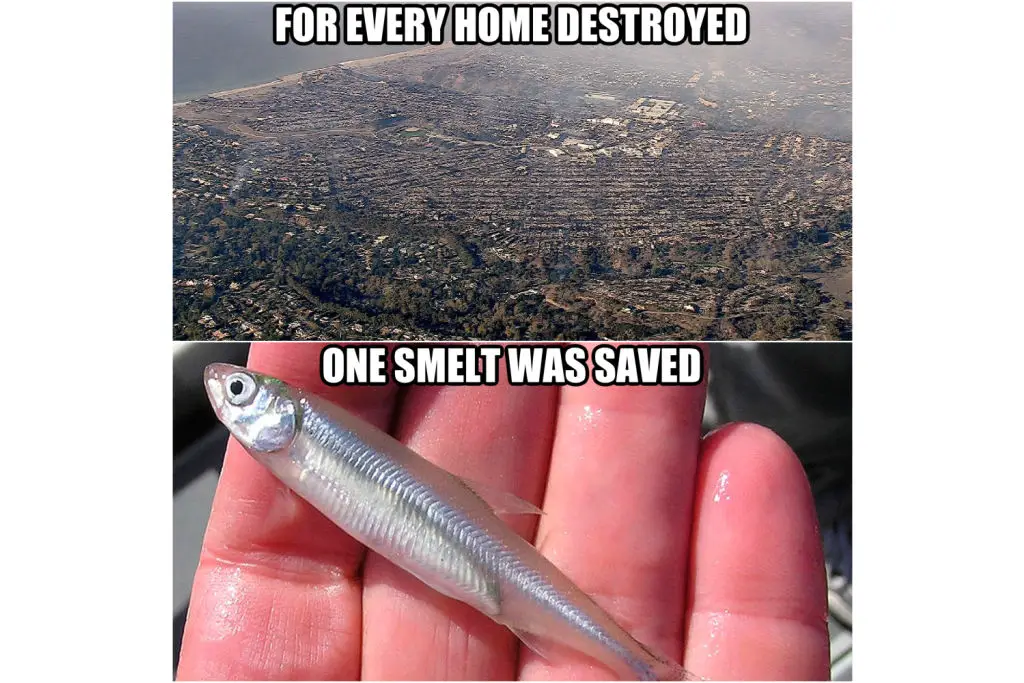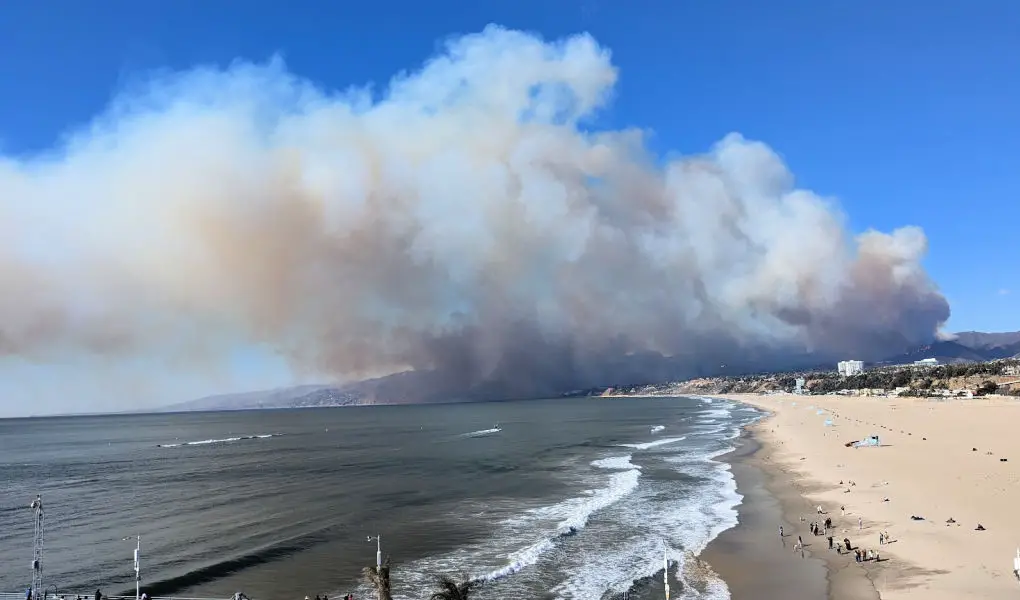So, someone just told you that the fires in Los Angeles have absolutely nothing to do with the Delta Smelt? Take a deep breath (preferably not near an active wildfire) and send them this article. Because oh, sweet summer child, the Delta Smelt is the plot twist in this fiery tale that no one saw coming.
Let’s Talk About the Reservoir That Forgot How to Reservoir
First up, meet the Santa Ynez Reservoir in the Pacific Palisades—a critical part of LA’s water system. This reservoir has the capacity to hold 117 million gallons of water, but for almost a year, it’s been sitting completely empty. Why? Apparently, it needed a new cover, and that cover has yet to materialize, leaving the reservoir out of service during critical moments. Nevertheless, the lack of urgency in repairing and refilling this crucial reservoir raises legitimate questions about whether the city has been prioritizing other concerns over public safety.
Here’s why that matters: fire hydrants don’t pull water directly from reservoirs. Instead, they rely on nearby water tanks that store water and maintain the pressure needed to deliver it where it’s needed most. These tanks continuously refill from reservoirs to ensure there’s enough supply to keep up with demand.
“This was supposed to be the water to put out the Palisades fire.”
The FP’s Austyn Jeffs visits the Santa Ynez Reservoir that has reportedly been empty since February 2024. pic.twitter.com/DwO5OrYhWk
— The Free Press (@TheFP) January 11, 2025
When a large fire breaks out, water usage surges as firefighters depend on hydrants to battle the flames. If the reservoirs aren’t full, the water tanks can’t refill quickly enough, leading to low pressure or even empty hydrants. This creates a cascading failure—exactly what happened during the recent fires when the Santa Ynez Reservoir’s empty state left the system unable to sustain the demand.
If you think about it, LA’s water system is complex and interconnected. The Santa Ynez Reservoir directly impacts the pressure and water supply in a wide area, including the ability to quickly fight fires. And when it’s empty, it severely hampers the ability of firefighters to access water when they need it most.
Enter: The Delta Smelt
Now here’s where things get spicy. The California Aqueduct, which is the main water source for Los Angeles, has been operating at reduced capacity for years because of—you guessed it—the Delta Smelt. This tiny fish lives up in the Sacramento-San Joaquin Delta and has become the star of an environmental battle royale.

To protect the smelt’s habitat, water flow through the aqueduct has been limited, even when there’s plenty of rain. And by plenty, we mean record-breaking November 2024 rainfall—water that could’ve filled up reservoirs faster than you can say “hydrant pressure.”
Instead, much of that glorious water is diverted into the ocean. Yes, the ocean.
Reservoirs Within LADWP – Very Thirsty
Meanwhile, LA’s reservoirs stayed parched, and the Santa Ynez Reservoir stayed about as useful as an empty kiddie pool during a heatwave. Now, here’s the thing: the Santa Ynez Reservoir, while not directly filled from the California Aqueduct, is part of an interconnected network of reservoirs within the LADWP (Los Angeles Department of Water and Power) system.
It receives its water through several critical connections with other reservoirs. One key pathway for this water flow is the Castaic Canal, which facilitates the movement of water from reservoirs connected to both the Los Angeles Aqueduct and the California Aqueduct.
DEI: LA Department of Water and Power CEO Janisse Quinones makes $750,000 per year. Listen to her explain how LA ran out of water. One job… pic.twitter.com/PV8rVlE2Vo
— @amuse (@amuse) January 9, 2025
While the California Aqueduct is the main water source for Southern California, the Santa Ynez Reservoir depends on water flowing from other reservoirs, including the Stone Canyon Reservoir and others in the LADWP system. The Stone Canyon Reservoir, located in the Santa Monica Mountains, collects both local runoff and imported water from the Los Angeles Aqueduct, which then feeds into the Santa Ynez Reservoir.
Require Meticulous Planning – Not Going to Happen With This Group
This interconnected system allows for the transfer of water through various channels, ensuring that even if one source runs low, others can step in to help. Of course, this doesn’t work on a whim—this kind of water management requires meticulous planning and coordination. Each reservoir, canal, and pipeline is carefully managed to ensure that water flows efficiently where it’s needed most, especially during critical times like wildfire season.
Adam Corolla with an EPIC ALL TIME RANT!!
— Department of Government Efficiency – TEMU Edition (@DeptOfGovtEffic) January 10, 2025
It’s not a “turn on the tap” situation; every movement of water is calculated, scheduled, and adjusted based on need, weather conditions, and current water levels. When one piece of this complex puzzle is out of sync—like, say, the Santa Ynez Reservoir being empty for nearly a year—it throws off the whole system, leaving the city vulnerable when it needs water the most. So, it’s not just about having water; it’s about having it at the right place, at the right time, in the right amounts. That takes a lot more than just good intentions—it requires serious foresight and planning.
LA Suffers From a Self-induced Drought
Now, Los Angeles, despite its sprawling urban landscape, has been living in a self-induced drought. Due to a mix of political and environmental decisions, a significant amount of water meant for the city is instead being pumped into the ocean. Instead of using this water for city needs, it’s being diverted for ecological preservation efforts, notably to protect endangered species like the Delta Smelt in the Sacramento-San Joaquin Delta.
Los Angeles is fed by aqueducts and does not “run out” of water.
This has not been the driest year
nor the driest season in LA’s history.
These are not the strongest Santa Ana winds on record.
This is criminal incompetence. Period
I love you, LA. I’m praying for you. Truly I am. pic.twitter.com/09u2csDSgO— Charlie LeDuff (@Charlieleduff) January 12, 2025
This ongoing strain is compounded by the state’s increasing reliance on permanent water restrictions. In July 2024, California took the historic step of introducing permanent water regulations for its largest cities and towns, including Los Angeles. For the first time ever, the state’s Water Resources Control Board mandated that urban water suppliers reduce their water deliveries by as much as 40% over the next 15 years. This regulation applies not just during droughts but as an ongoing measure to prepare for the growing challenges of climate change and population expansion.
Under this law, water utilities serving 95% of California’s residents will face strict restrictions aimed at addressing both current and future water shortages. These utilities will need to carefully calculate water budgets based on residential use, outdoor irrigation, and water loss due to leakage. And if they fail to meet these goals, hefty fines of up to $10,000 per day will be imposed. As a result, Los Angeles finds itself in a peculiar situation: facing permanent restrictions and yet, paradoxically, seeing precious water sent out to the Pacific Ocean, further exacerbating the ongoing water scarcity.
But Didn’t the Governor Say the Reservoirs Were Full?
Oh, Governor Gavin Newsom, bless his heart. He claimed that “the reservoirs are completely full,” which was…not accurate. It’s like saying your fridge is stocked when all you have is a half-eaten jar of pickles. Officials later admitted that the Santa Ynez Reservoir had been empty for nearly a year. The excuse? A much-needed cover that’s apparently still stuck in construction limbo.
NEW: Gavin Newsom accuses Trump of spreading “mis- and disinformation” about empty reservoirs during the Los Angeles wildfires.
Reporter: “Well, that one reservoir that serves the Palisades was not full.”
Newsom: “That’s exactly what we’re going to investigate.”
Incredible. pic.twitter.com/Vx8tFsa8jT
— KanekoaTheGreat (@KanekoaTheGreat) January 12, 2025
So, What Does This Mean for the Fires?
LA’s fires aren’t just about droughts or high winds. Sure, those factors pour gas on the metaphorical flames. But the root problem is the city’s inability to maintain water pressure during emergencies. Without enough water in the reservoirs, hydrants go dry, firefighting efforts stall, and everything burns faster than a marshmallow over a campfire.
And yes, the Delta Smelt restrictions play a role in this. By limiting water flow through the California Aqueduct, the state has created a situation where even record rainfall can’t replenish critical reservoirs.
We Need Your Help
Did you find this article helpful? If so, bookmark it and when you’re planning your next vacation, click on any of the links below before finalizing reservations. You’ll get the best price, we’ll earn a small commission, and you’ll help support future articles.
Thank you!
BEST TRAVEL SEARCH ENGINES
🏘️ Book Accommodation
We use Tripadvisor to compare prices and reviews in advance and check availability
✈️ Book Your Flight
To find the cheapest flight options, use Skyscanner to find the most suitable choice for you
🚗 Reserve Rental Car
Use Discover Cars to compare prices and view the largest selection of vehicles




